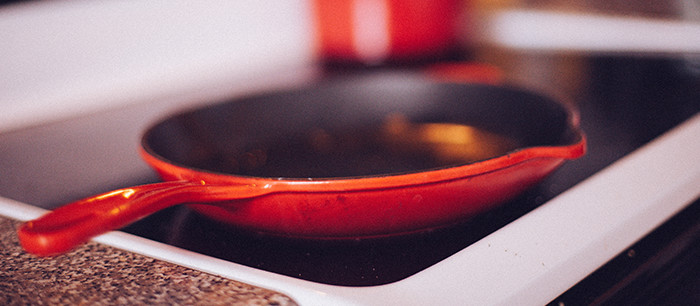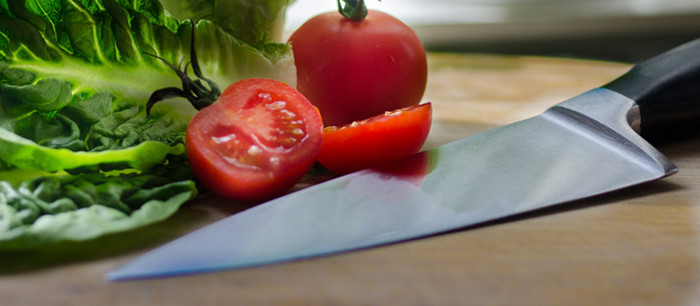If you’re like most parents, having a baby is an eye-opening experience on many levels. Suddenly, you start to notice things in your home and kitchen that could pose a hazard to your child. Instead of worrying about safety constantly, learn how to childproof your kitchen to ensure your kids are safe.
This blog is part of a series on how to childproof different rooms in your home. Also be sure to read part 1 of the series, on childproofing your living room.
Whether you’re expecting a child, have a toddler who’s starting to roam, or are planning to host guests with children, you’ll want to make sure your kitchen is protected from curious little creatures.
Take a look at your kitchen through the eyes of a child. Then, follow these tips to childproof your kitchen.
1. Block access entirely
The best way to keep your children safe from the dangers of the kitchen is to keep them out of the kitchen. Use gates on the doorways leading into the kitchen to block access.
Of course, there are times you’ll want your children with you in the kitchen. But gates are a way to prevent your child from entering the kitchen, and possibly getting hurt, when you’re not there to supervise.
2. Protect your cleaning supply cabinet
While it can be cute when your toddler gets into the cabinets to use the pots and pans for a drum session, finding his or her way into your cleaning supplies is no laughing matter. In 2014, around 43 out of every 1,000 children under age six were reported as exposed to poison, according to the National Capital Poison Center.
Prevent kids from getting into cleaning supplies and other toxic kitchen chemicals using child cabinet locks. There is a range to choose from, including magnetic locking systems, latches, or sliding locks.
When it’s time to plan a kitchen renovation project for your home, you can consider installing other protective elements and organizing your kitchen in a more child-friendly manner. For example, adding extra storage space can help you put away any sharp and dangerous items, such as toxic chemicals, your kids shouldn’t handle without your help or shouldn’t handle at all.
Use whichever lock will work best for you and your cabinets—and better yet, move your cleaning supplies to a higher cabinet for lockup.
3. Lock your dishwasher
Many dishwashers come with a built-in lock setting. Train yourself to use it! Otherwise, a few pulls could bring the dishwasher door crashing down on your toddler’s head. Or, your little one could get into the dishwasher where suddenly he has access to sharp knives, dirty dishes, and breakables.
Place knives in the dishwasher with the blades down, and never put detergent in the dishwasher until right before you start it. If your dishwasher doesn’t have a lock and doesn’t snap shut, use a childproofing latch to keep it closed.
4. Protect your stove

Protecting your child from burns from flames and hot food on the stove is one of the most important aspects of kitchen safety. Nearly 75 percent of all scalding burns in children are preventable, according to Johns Hopkins Medicine.
Consider installing a stove guard, which makes it hard for little hands to reach the burner, or pots on your cooktop.
If you have knobs on the front of your stove, keep your child from turning the burners on by using stove knob covers. When cooking, make sure pan handles don’t face forward, where they could be grabbed, and use the back burners when possible.
5. Lock the oven
If your oven has a locking mechanism, make sure it is engaged when your oven is not in use. Don’t hang your dishtowel from the oven handle, lest your child pull on it and get hit in the head with the oven door, or gain access to the oven.
If you have a freestanding or slide-in range, install it with anti-tip brackets, securing the rear legs to the floor.
6. Secure small appliances
Whether it’s your microwave, coffee maker, or food processor, make sure all small appliances that live on your countertops are secure. Place them at the rear of the counter, and don’t leave cords dangling over the edge.
Also put away or secure any step stools, chairs, or other objects that could provide your toddler or child quick access to your countertops when you’re not looking.
7. Store cutlery safely

Most likely, your butcher block of knives is located on your counter. If you’ve got small children, it’s time to relocate it. Store it in an above-the-counter cabinet instead.
Also make sure any sharp knives, pizza cutters, peelers, or other small but sharp kitchen utensils aren’t kept in drawers your little one can access.
8. Latch your refrigerator
Installing a childproofing latch on your refrigerator ensures your child doesn’t get into the fridge and consume any food he or she shouldn’t be eating. We’re not talking cake, but choking hazards like grapes, medicines stored in the fridge, or alcohol.
The same goes for your freezer, especially if it’s located below the refrigerator.
9. Cover your garbage disposal switch
Garbage disposals can cause serious injury with the flick of a switch. Place a cover over the garbage disposal switch in your kitchen to prevent your child from turning the disposal on when least expected.
Also make sure outlets are sealed off with safety plugs.
10. Keep the floor slip-proof
Prevent slips and falls in the kitchen by taking stock of how slippery the floor is. If your tiles are slippery, require children to wear shoes or other footwear they won’t slip in.
If you have rugs in the kitchen, make sure you have nonskid rug pads underneath. Also make sure any spills are wiped up promptly.
Looking for ways to keep your older kids safe, too? Read the five most effective ways to protect your kids, even when you’re not there.


